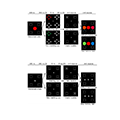Abstract
Current theories assume that there is substantial overlap between visual working memory (VWM) and visual attention functioning, such that active representations in VWM automatically act as an attentional set, resulting in attentional biases towards objects that match the mnemonic content. Most evidence for this comes from visual search tasks in which a distractor similar to the memory interferes with the detection of a simultaneous target. Here we provide additional evidence using one of the most popular paradigms in the literature for demonstrating an active attentional set: The contingent spatial orienting paradigm of Folk and colleagues. This paradigm allows memory-based attentional biases to be more directly attributed to spatial orienting. Experiment 1 demonstrated a memory-contingent spatial attention effect for colour but not for shape contents of VWM. Experiment 2 tested the hypothesis that the placeholders used for spatial cueing interfered with the shape processing, and showed that memory-based attentional capture for shape returned when placeholders were removed. The results of the present study are consistent with earlier findings from distractor interference paradigms, and provide additional evidence that biases in spatial orienting contribute to memory-based influences on attention.
